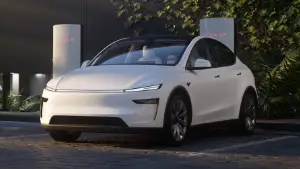- Price Gap: Is Xiaomi a Real Threat to Tesla?
- Range and Charging: Which SUV Is Better Suited for Long Drives in the GCC?
- Interior Tech and Comfort: Which SUV Delivers a More Refined Driving Experience?
- Infrastructure and Local Support: Who Is Closer to the Consumer?
Electric vehicle markets in Saudi Arabia and the UAE are witnessing rapid growth and intensifying competition between well established players and ambitious newcomers. While Tesla continues to strengthen its position as a leader in electric mobility, Chinese tech giant Xiaomi is stepping into the race with its all electric YU7, a model that blends futuristic design with an attractive price tag.
This rivalry presents GCC consumers with two distinct choices: a proven name with a strong track record and a bold contender aiming to redefine the smart car experience. In this comparison, we explore the key differences between the two SUVs in terms of pricing, driving range, interior features, and local availability and support.
Price Gap: Is Xiaomi a Real Threat to Tesla?

One of Xiaomi YU7’s strongest selling points lies in its pricing. Launched in the Chinese market at around 35,000 US dollars (approximately 131,000 SAR), the YU7 offers a compelling value proposition for those seeking a high tech electric SUV at an affordable cost. In contrast, the Tesla Model Y starts at 198,170 AED in the UAE, highlighting a clear price gap between the two competitors.

However, it is important to note that the YU7’s current pricing applies only to the Chinese market. Without an official launch or established import channels in the GCC, the actual price for local buyers remains uncertain for now.
Range and Charging: Which SUV Is Better Suited for Long Drives in the GCC?

The Xiaomi YU7 delivers impressive range performance, especially in its rear wheel drive variant that uses a 96 kWh LFP battery and achieves up to 835 kilometers based on the CLTC test cycle. The higher spec Max version is equipped with a 101 kWh NMC battery and offers a range between 760 and 770 kilometers. On paper, this gives the YU7 a significant advantage over the Tesla Model Y, whose official range in the RWD version is about 533 kilometers under the WLTP standard.

When it comes to charging speed, Xiaomi claims that the YU7 can charge from 10 to 80 percent in just 21 minutes in standard trims and as little as 12 minutes in the Max version. Tesla, on the other hand, relies on its Supercharger network, which can add around 275 kilometers of range in just 15 minutes, placing it among the fastest in its segment.

While both vehicles offer competitive charging capabilities, the YU7 clearly stands out in overall driving range. This makes it a compelling choice for long distance travel across the GCC, where wide open highways and long commutes demand electric vehicles that can go the distance without frequent charging stops.
Interior Tech and Comfort: Which SUV Delivers a More Refined Driving Experience?

The Xiaomi YU7’s interior showcases the brand’s strong focus on innovation and smart technology. It features a wide floating digital instrument panel in front of the driver, complemented by a large central touchscreen that controls everything from driving modes to entertainment.

The seats are upholstered in premium leather and come equipped with advanced features like ventilation, heating, massage, and a zero gravity recline function for the driver’s seat, offering exceptional comfort during stops. Optional extras include a built in refrigerator in the center console and dedicated tablet mounts on the back of the front seats.
On the safety front, the YU7 integrates an advanced ADAS suite, which includes a roof mounted LiDAR, 4D radar, 11 cameras, and 12 ultrasonic sensors, all powered by the high performance Nvidia Thor chip. This setup enables semi autonomous driving capabilities similar to Tesla’s most advanced systems.

By contrast, the Tesla Model Y adopts a minimalist approach to interior design, where nearly all functions are managed through a single 15 inch central touchscreen. The cabin features high end materials such as synthetic leather and open pore wood in newer trims, as well as a panoramic glass roof that enhances the sense of space. Tesla also frequently updates its software over the air, continuously improving performance and adding new features to enhance the driving experience.
Infrastructure and Local Support: Who Is Closer to the Consumer?

Tesla holds a clear lead when it comes to infrastructure and after sales support. The company inaugurated its first official center in Riyadh in mid 2025 and began delivering vehicles directly to customers shortly after. It is also expanding its presence with a new service center under construction in Jeddah. Tesla’s Supercharger network already covers key locations across major cities like Riyadh, Jeddah, and Dammam, offering owners a seamless and accessible charging experience throughout the Kingdom.

In the UAE, Tesla enjoys a well established footprint with showrooms and service centers in both Dubai and Abu Dhabi. A wide network of Superchargers is available along highways and at shopping centers, providing a comprehensive infrastructure that supports a hassle free ownership experience.

In contrast, Xiaomi remains in the early stages of market entry, limited so far to promotional appearances and event participation, such as the recent EV exhibition in Riyadh. As of now, the company has made no official announcement regarding a GCC launch for its EVs. There are no sales representatives, showrooms, or service facilities available locally. As a result, acquiring a Xiaomi YU7 would depend on future expansion or private imports, raising questions about service accessibility and spare parts availability in the short term.
2 / 11












